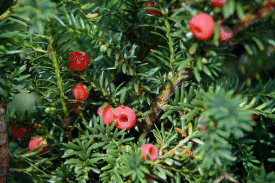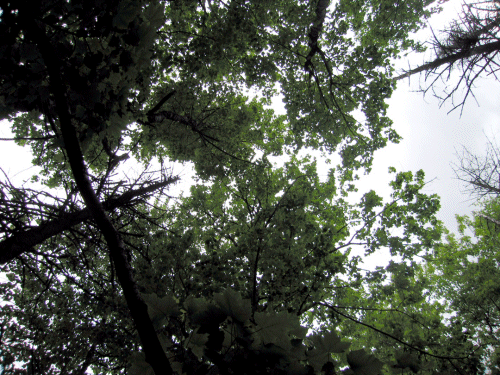Three years of research done by Agriculture and Agri-Food Canada in Prince Edward Island shows that ground hemlock can be planted and successfully grown in a forest setting, even with a dense canopy overhead.
Previous studies have focused on the establishment of ground hemlock as a commercial field crop, while few have examined its potential for growth under a native forest canopy.
Ground hemlock (Taxus canadensis), also known as Canada yew or eastern yew, is a native evergreen shrub that can be found in forests throughout eastern Canada. Ground hemlock is a low-spreading and relatively slow-growing shrub. Interest in commercial production of ground hemlock is due to its paclitaxel (Taxol®) content, which is used as a chemotherapy drug to treat several types of cancer.
Growing Ground Hemlock
The study showed that ground hemlock plants were easy to establish, grew well and remained healthy when planted under a range of canopy densities. Most growth was due to lateral plant spread rather than an increase in height, a normal growth habit in ground hemlock.
One objective of the project was to measure different tree canopy densities to determine which would be best for growing a commercial crop of ground hemlock from plants started as cuttings.
In the spring of 2005, 30 plants were established at each of five predominantly hardwood sites. The stand varied from site to site resulting in various overhead canopy densities. All sites were relatively flat while site 2 was located on a 15 degree slope facing north-west. Plants for the project were supplied by the Canadian Forest Service in Fredericton, N.B. and were large 3 year old stock.


Ground hemlock (Taxus canadensis) showing characteristic red fructification.
Researchers used a leaf area index or LAI to measure the density of the overhead tree canopy and compare growth at various locations and canopy conditions. LAI is a ratio of all light-blocking objects (leaves, branches) divided by the surface area of the land on which the ground hemlock vegetation grows.
Key Findings:
- Commercially grown plants of ground hemlock can be established in wooded areas in P.E.I.
- Ground hemlock can be grown under a range of canopy densities.

View of a forest canopy from the forest floor.
Plant health was measured by a visual standard score system based on pictures of healthy and unhealthy plants. The maximum height and width of each plant was measured and data from new growth areas was recorded.
Of the five sites in the study, site 2 had the most dense overhead canopy (Figure 1), but still showed good health, with reasonable spring growth (Table 1). Sparser canopies produced better growth rates.
The results show ground hemlock can be grown successfully without clearing wooded areas for a commercial field or plantation. Thinning of denser canopies may allow plants to grow more quickly. Knowing how the plants respond to various forest conditions is valuable information for farm operators and land owners interested in producing ground hemlock as a niche crop.
Figure 1. Leaf area index (LAI) and plant health standard scores.

Description - Figure 1
This figure shows the leaf area index (LAI) and the plant health scores for the five sites evaluated.
| Site | Leaf Area Index (LAI) Score | Plant Health Score |
|---|---|---|
| 1 | 1.3 | 3.8 |
| 2 | 4.3 | 4.2 |
| 3 | 3 | 3.7 |
| 4 | 2.9 | 3.4 |
| 5 | 2.5 | 3.9 |
Table 1 summarizes the plant growth at the five sites over a 2 year period. Several measurements were recorded to assess plant growth.
In general, a more open forest canopy with a lower LAI or greater light penetration produced better ground hemlock growth.
| Site | LAI | Fall Height (cm) |
Fall Width (cm) |
Spring Bud (#) |
Spring Growth (mm) |
|---|---|---|---|---|---|
| 1 | 2.68 | 78.3 | 46.0 | 10.3 | 13.0 |
| 2 | 6.21 | 72.0 | 45.3 | 5.4 | 6.9 |
| 3 | 4.71 | 82.7 | 55.3 | 9.1 | 13.5 |
| 4 | 3.61 | 78.9 | 46.3 | 5.3 | 13.9 |
| 5 | 4.28 | 80.5 | 52.3 | 5.9 | 17.3 |
| Site | LAI | Fall Height (cm) |
Fall Width (cm) |
Spring Bud (#) |
Spring Growth (mm) |
|---|---|---|---|---|---|
| 1 | 1.02 | 76.0 | 68.0 | 14.2 | 8.9 |
| 2 | 4.03 | 70.0 | 52.0 | 5.1 | 4.7 |
| 3 | 2.35 | 77.0 | 67.0 | 9.3 | 6.7 |
| 4 | 2.94 | 77.0 | 48.0 | 4.2 | 27.1 |
| 5 | 2.50 | 83.0 | 46.0 | 12.3 | 10.8 |